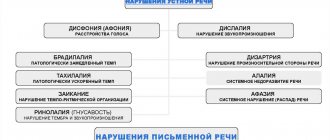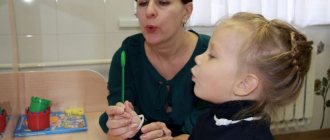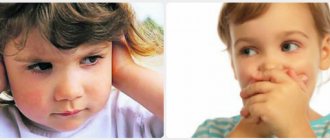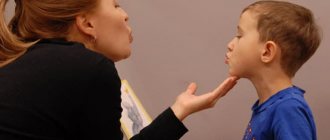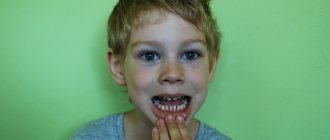Normal speech development is one of the important components of the harmonious development of a child’s personality and successful learning. But there is a category of children who have speech disorders. Such disorders include lexico-grammatical speech underdevelopment (LGSD).
This violation belongs to the psychological and pedagogical classification. Children with LGND are distinguished by preserved sound pronunciation and relatively developed phonemic processes (sometimes as a result of speech therapy assistance). But there is a lag in the level of vocabulary from the norm and the presence of agrammatisms in speech. Most often, this disorder is observed with general speech underdevelopment (GSD).
Forms of manifestation of LGNR
Often this disorder accompanies more serious speech disorders and is one of their symptoms:
- Exit from motor alalia. With this form of pathology, the process of language acquisition occurs. This is why LGNR occurs with this type of alalia.
- OHP of any degree.
- Speech development delay (SDD).
- Mental retardation (MDD).
- Dysarthria.
Underdevelopment of the lexico-grammatical aspect of speech is one of the main signs of these disorders. As a rule, its first symptoms appear at 3 years old, when the child begins to communicate in sentences and more actively explore the world around him.
Classification of speech disorders. Causes of speech disorders.
Based on materials from speech therapy literature, it was prepared by speech therapist V.N. Rychkova.
A child, when born, does not have an innate knowledge of the laws of the language he will speak. At a certain period of his development, he learns the norms and rules of the language spoken by the people around him. If for some reason language-speech-mental activity is not formed on time, then in the future this leads to disturbances in the child’s speech to one degree or another.
Classification of speech disorders
Psychological and pedagogical classification of speech disorders:
*Phonetic speech disorder or disorder of the pronunciation of individual sounds (NPOS). In this type, the phonetic side of speech (sound pronunciation, sound-syllabic structure of a word, prosody) as a whole or any individual components of the phonetic structure of speech (for example, only sound pronunciation or sound pronunciation and sound-syllabic structure of a word) are impaired.
*Phonological speech disorder (PSI ). This is the underdevelopment of phonemic processes (sound discrimination): phonemic perception, sound analysis and synthesis with normal sound pronunciation and the absence of agrammatisms.
*Phonetic-phonemic speech disorder (FFSD).
With FFND, along with a violation of the phonetic aspect of speech, there is also an underdevelopment of phonemic processes: phonemic perception (auditory differentiation of sounds), phonemic analysis and synthesis, phonemic representations.
*Lexico-grammatical speech underdevelopment (LGSD). With LGNR, children have normal sound pronunciation, phonemic processes are relatively preserved (most often as a result of speech therapy), but there is a limited vocabulary and a violation of the grammatical structure of speech (agrammatism).
*General speech underdevelopment (GSD I , II and III ). With OHP in children, all components of the language (speech) system are impaired: the phonetic-phonemic side of speech (sound pronunciation and sound discrimination), vocabulary (limited vocabulary), grammatical structure.
Clinical and pedagogical classification —
reveals the mechanisms, forms and types of speech disorders. The following forms of speech disorders are taken into account: dyslalia, dysarthria or an erased form of dysarthria, rhinolalia, voice disorders; motor and sensory alalia; aphasia, delayed speech development (SDD), stuttering and others.
* Dislali I - a violation of sound pronunciation with normal hearing and intact innervation of the speech apparatus.
*Dysarthria is a disorder of the pronunciation aspect of speech caused by insufficient innervation of the speech apparatus (damage to the speech motor mechanisms of the central nervous system).
*Alalia (motor and sensory) – absence or underdevelopment of speech due to organic damage to the speech areas of the cerebral cortex in the prenatal or early period of a child’s development.
*Aphasia is a complete or partial loss of speech caused by local brain lesions.
*Speech development delay (SDD) is a slower than normal acquisition of the native language (sound pronunciation, vocabulary, grammatical structure) .
Causes of speech disorders.
Adverse internal factors affecting the brain during the period of its intensive development lead to a delay in the development of the child as a whole. These include: intrauterine pathology (intoxication, infectious diseases of the mother, toxicosis of pregnancy); injuries during childbirth (birth injuries, asphyxia, intracranial hemorrhage); hereditary factors (chromosomal disorders and genetic changes); compatibility of mother and fetus (Rh factor).
They lead to minimal organic brain damage in the infant, which is characterized by lack of attention, weakened memory, lag in motor development, disinhibition and, as a consequence, lag in speech development.
The use of alcohol, nicotine and drugs during pregnancy is especially harmful. This leads to disturbances in the physical and neuropsychic development of the fetus. Women who smoke, drink and use drugs give birth to children with low body weight and lagging behind in physical and mental development.
Unfavorable external factors : lack of an emotionally positive environment; individual characteristics of the mother (suspiciousness, anxiety, emotional coldness), insufficient attention to the child from adults, or, conversely, overprotection; raising a child in two houses, when the child alternately lives with divorced parents.
Etiology
The causes of LGNR can be divided into two large groups - biological and social. The first category includes:
- adverse effects on the fetus during pregnancy (especially on the brain);
- difficult course of pregnancy;
- trauma during childbirth;
- asphyxia;
- severe infectious diseases in the first year of a baby’s life.
Social ones include:
- unfavorable social conditions and speech environment in which the child grows up;
- prolonged stress;
- lack of emotional communication with family;
- overprotection;
- bilingualism.
The genetic predisposition of children to speech disorders causes controversy among experts. Some believe that this feature is passed on genetically. Another group believes that a child can simply imitate an adult who has a speech impediment.
Description of symptoms
LGNR is expressed not in a violation of sound pronunciation, but in underdevelopment of vocabulary and difficulties in mastering grammatical categories. The impressive vocabulary is sharply behind the norm; the child uses words in speech with the wrong meaning. He has difficulty classifying objects; he cannot find generalizing words. Due to delayed vocabulary, children with LGND have difficulties in understanding speech.
His phrases and sentences are ungrammatical. The norms of agreement in gender, number and case are violated. In the speech of children with LGND, nouns predominate rather than adjectives and verbs. A preschooler has difficulty or does not form possessive pronouns and adjectives at all. Numerals, adverbs, and participles are practically not used in speech.
Most often, such children communicate through phrases and uncommon sentences. They do not use prepositions or conjunctions. Their answers to questions are not extensive; they are usually monosyllabic. Also, children with LGNR have difficulties in word formation, especially in the prefix-suffix way.
LGNR also affects the quality of coherent speech. A preschooler cannot independently compose a story or retell a story. Children with such features of speech development do not write descriptive stories because it is difficult for them to select words that are similar in meaning. All this affects the child’s need for communication. If this defect is not corrected in time, it may cause a violation of written speech. Successful exit from LGNR depends on how early correctional work was started.
ONR
General speech underdevelopment
(OHD) are “various complex speech disorders in which the formation of all components of the speech system is disrupted, that is, the sound side (phonetics) and the semantic side (vocabulary, grammar) with normal hearing and intelligence.”
Children with OSD have typical manifestations (despite the different nature of the defects) indicating systemic disorders of speech activity:
- late onset of speech: the first words appear by 3-4, in extreme cases, by 5 years;
- speech is agrammatic and insufficiently phonetically designed;
- expressive speech lags behind impressive speech, that is, the child, while understanding the speech addressed to him, cannot correctly express his thoughts;
- the speech of children with SEN is difficult to understand
It should be noted that OHP can also be a secondary defect due to hearing or intellectual impairment. Therefore, diagnosis requires a comprehensive examination of specialists in various fields: speech therapist-defectologist, neuropsychologist, neurologist, and possibly an otolaryngologist, neuropsychiatrist, surgeon.
With general underdevelopment of speech, there are simultaneously violations of the sound side of speech, phonemic processes, vocabulary and grammatical structure of speech in children with normal hearing and intelligence.
OHP may be present in other forms of speech disorders, for example, motor, sensory or sensorimotor alalia, childhood aphasia, dysarthria.
General speech underdevelopment can be expressed to varying degrees: from complete absence to minor deviations in speech development.
There are four levels of speech development that reflect the typical state of language components in children with SLD:
- Level I OHP is characterized by the absence of speech. This is a group of so-called “non-speaking children”. Nevertheless, they have “babbling speech”.
- II level of OHP. In addition to gestures and “babbling speech,” somewhat distorted, but fairly constant, commonly used words appear. The development of speech and pronunciation of such children lags significantly behind the age norm.
- Level III OHP is characterized by lexico-grammatical and phonetic-phonemic underdevelopment in extensive phrasal speech.
- Level IV OHP is characterized by slurred speech, insufficiently clear distinctions between sounds in speech, rearrangement of syllables and sounds in individual words, abbreviation of word endings and the use of incorrect case endings.
Most often, OHP occurs as a result of the influence of several factors at once: for example, birth injuries, hereditary predisposition, and an unfavorable social environment. In the case of damage to the child’s central nervous system that occurred during the mother’s pregnancy, during childbirth and the first year of the child’s life, ONR will be expressed in a rather complex and persistent form.
To correct general speech underdevelopment, an integrated approach is required, the main goal of which will be to implement the most effective and correct overcoming of this disorder.
This approach provides for comprehensive correctional work of several specialists: a speech therapist, a neuropsychologist, and in some cases a neurolinguist and a psychotherapist. Make an appointment Addresses and telephone numbers of branches in Moscow Ask a question Reviews
Diagnostic features
The speech therapist selects visual material depending on the age of the child. When examining the lexical and grammatical aspects of speech, the specialist pays special attention to:
- state of vocabulary (impressive and active);
- mastery of word formation skills;
- the ability to coordinate words in phrases and sentences;
- which parts of speech the child uses more;
- development of coherent speech.
The child is asked to complete a task of generalization and comparison of objects. The speech therapist pays attention to how well the baby understands the speech addressed to him. He is also asked to form possessive adjectives and pronouns; make up new words. To assess coherent speech and mastery of grammatical categories, a speech therapist observes how the child communicates outside of educational activities.
For diagnosis, the child is asked to compose a story based on the picture. During this task, the specialist assesses how often the child uses common sentences; does the words agree? Do you need the help of an adult when compiling them? In addition, the list of tasks includes working with synonyms and antonyms.
Based on the results of the examination, the speech therapist selects special exercises that will most effectively correct this speech disorder.
Principles and visual methods of speech therapy
When to contact a speech therapist? Adults need speech therapy rehabilitation after a stroke, traumatic brain injury, or brain tumors. Children need consultation with a speech therapist in the following cases:
- a child of one and a half to two years old does not pronounce the words “mom”, “dad”, “top-top”;
- the baby is silent until the age of three, although he understands speech addressed to him;
- the child is lagging behind in speech development;
- after traumatic brain injury;
- By the age of five, a child nasals, burrs, lisps, and pronounces sounds incorrectly;
- baby at five, the child doesn’t remember words well.
From the age of three, children are recommended to undergo an annual consultation with a speech therapist, even if their parents think that everything is fine. Intensive development of the cerebral cortex in children continues until the age of 6-7 years. It is better to deal with speech therapy problems before school, and it is worth starting early.
What is the difference between a speech therapist and a speech pathologist? A defectologist has a specialization in “defectology”. He works with children with physical and mental disabilities. A speech therapist works with children without mental retardation or disruption of the central nervous system. He teaches the correct pronunciation of sounds and syllables. The tasks of a speech therapist at school are the correction and prevention of reading and writing disorders.
Speech therapy is based on the following basic principles:
- consistency;
- complexity;
- development principle;
- consideration of speech disorders in relation to other aspects of the child’s mental development;
- the principle of taking into account the causes and mechanisms of speech defects.
Speech therapy methods are conventionally divided into several groups:
- organizational – comparative, longitudinal (study over time), complex;
- empirical – observation, experimental, psychodiagnostic (tests, questionnaires, interviews), biographical (collection and analysis of the patient’s life history);
- quantitative and qualitative analysis of the obtained data, their machine processing using electronic computers and computer programs;
- interpretative – methods of theoretical study of connections between the phenomena being studied.
Technical means that ensure the objectivity of the study are widely used: intonographs, nasometers, spectrographs, video speech, phonographs, spirometers and other modern equipment. X-ray film photography, cinematography, electromyography, glottography make it possible to study the dynamics of holistic speech activity and its individual components. Neurological problems are also studied in speech therapy.
Features of working on improving vocabulary
With LGNR, the main attention is paid to correcting vocabulary, grammatical structure and coherent speech. Work on the lexical component is carried out in the following areas:
- expansion and activation of vocabulary;
- its clarification;
- developing the ability to use generalizing words:
- developing an understanding of complex grammatical structures.
It is best to start working on understanding speech in the context of objective activity. Thus, not only the vocabulary will be enriched, but also its clarification and use in active speech.
By completing tasks using generalizing words, the child learns a specific lexical topic. He learns to classify objects into categories; compare according to various criteria. To consolidate the acquired skills, the speech therapist asks what a certain word means, when it is used in speech, etc.
Work is being carried out not only on updating nouns, but also adjectives, verbs and other parts of speech. It is best to introduce them into active speech in combination with objective activities. For example, adjectives when examining objects, selecting synonyms. Verbs - directly when performing any action; numerals - during counting, etc.
The state of vocabulary affects both the acquisition of grammatical categories and the quality of coherent speech. But the correction of these important components must be carried out in combination for the classes to be effective.
Test with answers: “Speech therapy”
I option.
1. What is meant by exogenous-organic causes of speech disorders: a) traumatic brain injury + b) incorrect speech of others c) bilingualism in the family
2. Which of the following cranial nerves does not innervate the organs of the peripheral speech apparatus: a) vagus b) olfactory + c) trigeminal
3. What speech disorder is caused by organic damage to the peripheral part of the speech-motor analyzer: a) alalia b) aphasia c) mechanical dyslalia +
4. Which speech disorder does not belong to the disorders of means of communication identified within the framework of the psychological and pedagogical classification: a) stuttering + b) FFF c) ONR
5. In which structural and functional block of the brain is the kinesthetic analysis of articulatory movements carried out: a) block 3 b) block 2 + c) block 1
6. It is necessary to select the main biological factor for the occurrence of alalia: a) organic damage to the speech zones of the left hemisphere b) bilateral organic damage to the central nervous system + c) left hemisphere organic damage to the central nervous system
7. What principle of examining children with alalia aims at studying all aspects of speech, as well as non-verbal mental functions: a) systematic approach b) ontogenetic c) integrated approach +
8. Which of the following areas is the most important at the initial stages of working with non-speaking children with motor disabilities according to the language approach: a) enrichment and activation of subject vocabulary + b) enrichment and activation of predicative vocabulary c) formation and development of articulatory motor skills
9. What is OHP: a) violation of the pronunciation side of speech b) violation of pronunciation due to insufficient innervation of the articulatory apparatus c) systemic underdevelopment of all components of the language system +
10. What form of stuttering is caused by psychogenic causes: a) organic b) neurosis-like + c) neurotic
11. A violation of the organization of the tempo-rhythmic aspect of speech may be based on: a) organic damage to the cerebellum + b) organic damage to the medulla oblongata c) organic damage to the extrapyramidal system
12. The lack of formation of which structural and functional block will you predict when you identify errors in written work when replacing paired consonants: a) block of programming, regulation and control b) block of receiving information processing and storage + c) block of regulation of tone and wakefulness
13. On what sounds do stutterers most often experience cramps during speaking: a) vowels + b) consonants c) fricative consonants
14. Which vocal register should be practiced in people who stutter at the initial stages of work on developing skills of rational vocal delivery: a) laryngeal b) head c) chest +
15. What term denotes persistent, repeated errors associated with difficulties in mastering and applying spelling rules: a) dysorthographic + b) spelling c) calligraphic
16. What is the unit of the phonological code of a language: a) sound b) phoneme + c) word
17. What is the unit of the lexical code of a language: a) phrase b) sentence c) word +
18. What is the unit of the syntactic code of a language: a) word b) sentence + c) phrase
19. What is evidenced by the child’s transition from physiological tongue-tiedness to dyslalia based on the type of distortions in the pronunciation of speech sounds: a) primary inferiority of the organs of articulation b) lag in the formation of phonemic hearing c) progress in the formation of phonemic hearing +
20. What is the primary defect in optical dysgraphia, dyslexia: a) impairment of phonemic hearing b) impairment of the generalized optical image of the letter + c) impairment of phonetic hearing
Option II.
1. What is the cause of motor and oculomotor dysgraphia and dyslexia: a) impairment of hand, finger praxis or oculomotor functions + b) impairment of phonetic hearing c) impairment of phonemic hearing
2. Which speech disorder primarily affects the fluency and rhythm of speech: a) alalia b) stuttering + c) dyslalia
3. What disorder is associated with paralysis or paresis of the speech muscles: a) stuttering b) dyslalia c) dysarthria +
4. Correct spelling of which sentence requires the assimilation and implementation of the phonetic principle of Russian spelling:” a) “Here is my house” b) “Here is my dog” + c) “Here is my parachute”
5. Identify specific errors characteristic of phonemic dyslexia: a) replacement of graphically similar letters b) change in the form, tense of verbs c) violation of the sound-syllable structure of the word +
6. At what stage of the formation of reading skills, identified by Egorov, does a semantic guess take place at the level of the entire text: a) the stage of formation of synthetic reading techniques b) the stage of synthetic reading + c) the stage of syllabic-analytical reading
7. With the help of what control is the feedback mechanism implemented in the speech functional system: a) kinesthetic + b) visual c) tactile
8. What violations of sound pronunciation are an indicator of alalia in the differential diagnosis of it with dysarthria: a) substitutions b) omissions c) distortions +
9. What is FFNR: a) violation of the pronunciation side of speech + b) violation of the syllabic structure of the word c) unformed lexical and grammatical categories
10. What speech rate is typical for stuttering: a) accelerated b) intermittent + c) slow
11. What is speech therapy? a) the science of the psychophysical characteristics of the development of children with mental and (or) physical disabilities, the patterns of their education and upbringing b) the science of speech disorders, methods of their prevention, identification and elimination by means of special training and education + c) the branch of defectology that studies problems education and training of mentally retarded people and issues of their social rehabilitation
12. What is the subject of speech therapy as a science? a) speech disorders and the process of training and education of persons with speech disorders + b) a person (individual) suffering from a speech disorder c) pathological mechanism that determines the occurrence and development of speech disorders
13. The structure of a speech defect is: a) a set of signs (manifestations) of a speech disorder b) the nature of deviations in the functioning of processes and operations that determine the occurrence and development of speech disorders c) a set (composition) of speech and non-speech symptoms of a given speech disorder and their nature connections+
14. The “pedagogical process aimed at the correction and compensation of speech impairments, the upbringing and development of a child with a speech impairment, is understood as: a) correction of speech impairments b) compensation c) speech therapy intervention + d) decompensation
15. A qualitatively low level of development compared to the norm of a particular speech function or the speech system as a whole is: a) speech underdevelopment + b) speech development disorder c) speech disorder d) speech development delay
16. What is the slowdown in the rate of speech development called, in which the level of speech development does not correspond to the age of the child: a) speech underdevelopment b) speech development disorder c) speech disorder d) speech development delay+
17. Select the causes of speech disorders that were identified by M.E. Khvattsev: a) organic, functional, socio-psychological, psychoneurological+ b) anatomical-physiological, mental, functional c) organic, social, psychogenic, psychophysiological d) anatomical-physiological, psychophysiological, social
18. Subtle, systematized hearing, which has the ability to carry out operations of discrimination and recognition of phonemes that make up the sound shell of a word - this is: a) musical ear b) physical hearing c) phonemic perception d) phonemic hearing+
19. Excessive involuntary movements that occur due to disorders of the nervous system are: a) ataxia b) hyperkinesis+ c) paresis d) synkenesis
20. Pathological repetition or persistent reproduction of any action or syllable, word is: a) contamination b) perseveration+ c) anticipation d) accommodation
Features of working on grammatical structure and coherent speech
Classes are conducted in the following areas:
- formation of word formation skills;
- mastering the skill of coordinating not only nouns with adjectives, but also with other parts of speech;
- composing complex common sentences;
- compiling a descriptive story based on a plot picture.
The speech therapist works with the child on the use of various grammatical structures. Teaches the use of prepositions and conjunctions in speech. Tasks are offered for the declension of nouns, adjectives, and verbs. In addition to improving grammatical structure, work is being done in parallel to develop coherent speech.
The specialist’s task is not just to teach how to compose a story without the help of an adult, but so that the child can establish logical connections between sentences. At the beginning of the work, the speech therapist helps through leading questions and drawing up a hint plan. Then, gradually, the baby learns to independently give detailed answers and talk about familiar topics.
In addition, work is underway on intonation expressiveness. The child is introduced to the peculiarities of using interrogative and exclamatory intonation. It can be well practiced by staging theatrical performances, expressive reading and memorizing poems.
General speech underdevelopment
The diagnosis of general speech underdevelopment (GSD) is a violation of the entire language system.
This diagnosis is outdated; in the modern view, this diagnosis has been renamed motor alalia, and the levels characteristic of OHP can be attributed to the degree of impairment of the language system.
You can learn more about motor alalia here.
What is typical for each level?
There are 3 levels of ONR According to R.E. Levina, T.B Filicheva identified 4 levels.
Criteria for level 1:
* Almost complete absence of speech (this is where the concept of “speechless children” came from)
* Use of babbling words, onomatopoeic complexes
* The child “helps” himself with gestures and facial expressions
* The passive dictionary exceeds the capacity of the active dictionary
* Knows and understands a lot, but does not speak
* Replacement of several concepts with one word that is easier for the child to pronounce
* “Peepi” can mean I want to go to the toilet and let’s go for a walk
* “Bibi” - plane, car, go
* Long-term use of one-part sentences
* If the sentence expands to 3-4 words, then the construction is incorrect (Ma dya me pi-Mama give me a drink)
* Reducing the number of syllables in complex words (instead of dog-ka or baka, bye-ka)
* Children do not understand sound analysis tasks, for example in the task: clap when you hear the sound RRRRR...
* Phonemic perception is grossly impaired. Difficulty distinguishing words that sound similar and have different meanings
hammer - milk, digs - rolls - bathes)
Classical speech therapy sets the following age limits: up to 3 years - ZRR, from 3 years - ONR.
Criteria for level 2:
* In addition to gestures and babbling words, although distorted,
but fairly constant common words. Kaputn, lead, lyabaka. (Cabbage, tomato, apple)
* A story based on the picture is possible only with the help of leading questions, it is constructed primitively, in short phrases
*Limited vocabulary:
ignorance of many words denoting parts of an object (branches, trunk, roots of a tree)
(bottom, handle, spout, lid) - this is for the teapot.
* Signature words denoting shape, color, material are not used.
For example, yellow, oval, hard, sour.
* Gross errors in the use of grammatical forms:
“rode gokam” - rides on a slide;
“Kolya pityala” - Kolya wrote;
“da pamidka” - two pyramids;
"Asin adas" - red pencil
* As a rule, children with level 2 do not use prepositions in speech at all.
* The syllabic structure of the word is grossly violated.
“skovoda” - frying pan, “basagi” - boots.
* The pronunciation of most sounds is impaired (soft and hard, hissing, whistling, sonorant, voiced and voiceless)
* Phonemic hearing is not formed.
the child finds it difficult to correctly select a picture with a given sound, determine the position of the sound in a word, etc.
Criteria for level 3:
* Expanded speech appears, the child uses phrases with elements of lexical-grammatical and phonetic-phonemic underdevelopment.
— Dad went to work.
- Mom bought me a car and some candy.
* Already able to independently compose a short story about themselves, about their friends, about the events that happened to them
* In spontaneous speech, sounds are not always clearly defined, even if the child can pronounce this sound.
“syarf” - scarf, “lyba” - fish
* All parts of speech are used in communication, grammatically correct construction of SIMPLE sentences
* Vocabulary is rapidly increasing in volume, but lexical errors are observed:
- replacing the name of a part of an object with the name of the whole object (the dial is a “clock”)
- substitution of names of professions with names of actions (ballerina - “aunt dancing.”
- replacement of specific concepts with generic ones and vice versa (sparrow - “bird”; trees - “Christmas trees”
- interchange of characteristics (tall, wide, long - “big”, short - “small”).
* Phonemic hearing is not sufficiently formed.
Problems arise with phonemic analysis and synthesis (by school, these violations are quickly identified)
What sounds make up the word CAT, HOUSE.
Add the syllable RA to “ARC”, what happens?
Criteria for level 4:
* In the speech of children, there are isolated violations of the syllabic structure of the word and sound content.
- syllable reduction;
- rearrangement of sounds
* Due to sluggish articulation and unclear diction, one gets the impression of slurred speech
* Violation of semantic speech.
- there are no words denoting some animals and birds (penguin, ostrich), plants (cactus, loach), people of different professions (photographer, telephone operator, librarian), body parts (chin, eyelids, feet)
* When denoting actions and signs, children use names of approximate meaning.
oval-round;
* Lexical errors manifest themselves in the replacement of words that are similar in situation.
- the cat rolls the ball - instead of “ball”
- high fence - long;
- grandfather is old - an adult.
* Children have difficulty distinguishing between male and female persons.
-my book, my robot.
* Word formation using suffixes causes great difficulties, as well as the formation of possessive adjectives.
- strap - strap;
- volkin - wolf, fox - fox.
* Coherent speech is very peculiar.
When composing a story on a given topic, a picture, a series of plot pictures, the logical sequence is broken, there are missing chapters.
* There are difficulties when talking about events from your life; they use simple, uninformative sentences.
Reasons for OHP:
Organic causes
* intrauterine pathology that occurs during the period from 4 weeks to 4 months of fetal development;
* organic lesions of the peripheral speech organs;
* incompatibility of the Rh factor of the blood of mother and child;
* asphyxia.
Functional reasons
* Various deviations of mental processes such as excitation and inhibition in the central nervous system.
Social and psychological reasons
* adverse environmental influences;
* alcohol and nicotine consumption during pregnancy.
Genetic factors
Correction of the disorder must be systematized and constant; an experienced specialist must build an individual program for the child.
You can read more about the correction here.
Correction forecast
The effectiveness of corrective work depends on how early LGNR was identified. The sooner, the better the result will be. With timely speech therapy assistance before entering first grade, it is possible to cope with this disorder. Or you can reduce the gap from the norm as much as possible.
The outcome is also influenced by the characteristics of the speech disorder. The more complex it is, the longer it will take to corrective work to develop the necessary skills. During schooling, LGNR can cause the development of dysgraphia and dyslexia. Therefore, correctional work should be carried out in preschool age.
LGND is usually part of a more complex speech disorder. Therefore, the speech therapist draws up a lesson plan to eliminate the cause of any defect. This disorder becomes more noticeable after 3 years, when the baby begins to interact more actively with the outside world.
To prevent the occurrence of LGNR, adults need to communicate more with the child and be interested in his opinion. While walking, practice some areas for developing lexical and grammatical structure. After all, parents also have an important influence on speech development. Therefore, the speech therapist and parents must interact together so that the child has beautiful and literate speech.
SOUND PRONUNCIATION DISORDERS: PROBLEM OR AGE FEATURE?
One of the most common reasons for parents to contact a speech therapist is the child’s incorrect pronunciation of sounds. The specialist’s task is to figure out whether there are age-related characteristics in the development of children’s speech or whether it is a speech disorder – dyslalia, which requires special speech therapy sessions to eliminate it. Dyslalia is a violation of the pronunciation of one or more sounds or several groups of sounds. Patients with dyslalia always have normal hearing and preserved innervation of the speech apparatus.
Dyslalia is more common in children, less common in adolescents and adults. Usually the pronunciation of the following articulatory groups of sounds is impaired: whistling sounds (S, Z, Ts), hissing sounds (Sh, Zh, Ch, Shch), sonorants (R, L, Y), less often back-lingual (K, G, X) or front-lingual ( T, D). With systematic training, the active participation of parents in the correction process, and the use of modern methods of speech therapy, dyslalia can be successfully corrected.
Dyslalia is manifested by the following types of sound pronunciation disorders:
- skipping sounds - a sound “falls out” from the beginning, middle or end of a word, there is no sound (.opata, go.ub, foam.);
- replacement of sounds - the constant replacement of one sound with another sound of the native language in all forms of speech, due to the inability to distinguish the replaced sound and its “substitute” according to their pronunciation or auditory characteristics (R to L, K to T, Sh to S: Sapka, KoSka, MalyS .MaSa goes to Skola);
- mixing of sounds - sounds are sometimes pronounced correctly in simple forms of speech (syllables, words), sometimes erroneously - they are mixed (confused by the child, interchanged) in his speech utterances (fluffy braid, SuShtry baby);
- distortion of sounds - instead of the necessary sound, an unstandardized sound is used, which is absent in the system of the native language (throat R, interdental S, lateral Ш).
Taking into account the number of disturbed sounds, simple and complex forms of dyslalia . In simple cases, the pronunciation of one to three sounds is impaired; in complex cases, the child pronounces more than four sounds incorrectly. If the disturbed sounds belong to one articulatory group (С, Сь, З, Зь, Ц – whistling) – monomorphic dyslalia , if the pronunciation of sounds from several articulatory groups simultaneously suffers (Ч, Ш – hissing and Л, Р, Рь – sonorant), then this is polymorphic dyslalia .
The reasons for the formation of incorrect pronunciation are defects in the structure of the articulatory apparatus (short frenulum of the tongue or upper lip, high Gothic palate or low flat upper palate, malocclusion, structure and location of the dentition (gaps, sparse teeth), non-closure of the lips, thick sedentary lips, pathologically large or, conversely, the tongue is too small). If there is a deviation in the structure of the speech apparatus, we are talking about the presence of a mechanical form of dyslalia.
Functional dyslalia is caused primarily by social factors and is often associated with the characteristics of the child’s speech education. The speech of adults is an unconditional role model, therefore, unclear speech of others, imitation of baby babble, lisping of adults with a baby, upbringing in a bilingual family, unfavorable environment, limited scope of communication, delayed speech development, lack of control over the child’s speech and ignoring mistakes in childhood pronunciation can provoke the formation of incorrect articulatory patterns of sounds, underdevelopment of auditory perception and phoneme discrimination, which will lead to sound pronunciation disorders in preschoolers.
It is worth mentioning separately about such an age-related form of sound pronunciation impairment as physiological dyslalia . This includes those features of sound pronunciation that are the norm for a certain age stage and naturally arise in most children in the process of mastering the pronunciation system of their native language. The basis of the physiological form of dyslalia (age-related non-pronunciation of sounds) is insufficient age-related mobility of the articulatory organs and weakness of auditory discrimination of phonemes, which is successfully corrected as the child grows up by the age of 4-5.
So, for example, the age norm for children under 3 years old is a softened pronunciation of sounds (syanka, zyayka, tiplenok), up to 4 years old it is allowed to replace hissing sounds with whistling ones (sapka, zouk, taynik), up to 5 years old omission or replacement of sounds L and R ( .ozhka, laketa). Age-related disorders of sound pronunciation are manifested by substitutions, omissions and mixtures of sounds and are acceptable in the speech of a preschooler up to 4-5 years old. Distorted pronunciation of sounds at any stage of speech development is not an age norm and requires mandatory speech therapy classes.
With dyslalia, the pronunciation or acoustic characteristics of sounds are unformed and a different type of pronunciation disorder occurs: phonetic defect (distortion of sounds) or phonological defect (replacement and confusion of sounds). Taking into account the nature of the defect, the following types of dyslalia are distinguished: articulatory-phonetic, articulatory-phonemic and acoustic-phonemic.
Determining the type of dyslalia is very important for choosing techniques and methods for correcting speech disorders. The effectiveness of speech therapy also depends on the age at which correctional work begins: it is advisable to correct violations of sound pronunciation before entering school, so that deficiencies in the pronunciation of sounds do not affect the mastery of written speech.
The use of game methods in speech therapy work with preschoolers significantly increases the child’s interest in learning and helps to achieve positive results in a shorter time.
Teacher-speech therapist Gaiduk T.N.
